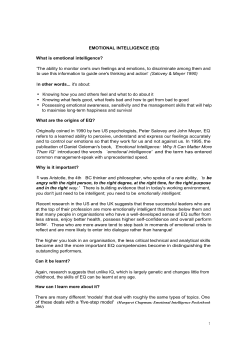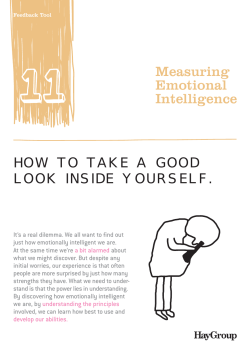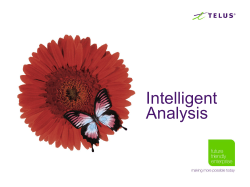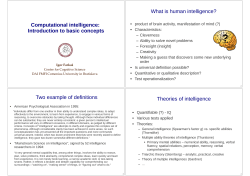
L&D 2.2 What Is Emotional Intelligence?
L&D 2.2 What Is Emotional Intelligence? ...There are many possible definitions of emotional intelligence, and many definitions can be found on the Internet. Many of these definitions stem from the popularizations of emotional intelligence found in the popular press and in popular books... A clear and scientifically useful definition of emotional intelligence, however, is recognizable because it takes the terms emotion and intelligence seriously. That is, the meaning of emotional intelligence has something specific to do with the intelligent intersection of the emotions and thoughts. For example: Emotional intelligence represents an ability to validly reason with emotions and to use emotions to enhance thought. A more formal definition is... We define EI as the capacity to reason about emotions, and of emotions to enhance thinking. It includes the abilities to accurately perceive emotions, to access and generate emotions so as to assist thought, to understand emotions and emotional knowledge, and to reflectively regulate emotions so as to promote emotional and intellectual growth (p. 197 of this article). Here is another definition my colleagues and I have employed: Emotional intelligence refers to an ability to recognize the meanings of emotion and their relationships, and to reason and problem-solve on the basis of them. Emotional intelligence is involved in the capacity to perceive emotions, assimilate emotion-related feelings, understand the information of those emotions, and manage them. (p. 267 of this article). Emotion. In this model, emotion refers to a feeling state (including physiological responses and cognitions) that conveys information about relationships. For example, happiness is a feeling state that also conveys information about relationships -- typically, that one would like to join with others. Similarly, fear is a feeling state that corresponds to a relationship -- the urge to flee others. Intelligence. In this model, intelligence refers to the capacity to reason validly about information. This use of the term emotional intelligence in this fashion is consistent with scientific literature in the fields of intelligence, personality psychology, and emotions (for more, see the similar discussion in this article). For example: Verbal intelligence concerns the mental ability to reason with and about verbal information, and of verbal knowledge to enhance thought. Spatial intelligence concerns the mental ability to reason with and about spatial information (i.e., the shape of objects and their orientation in space), and of spatial knowledge to enhance thought. ...and so on. References 1 1. Mayer, J. D., Caruso, D., & Salovey, P. (1999). Emotional intelligence meets traditional standards for an intelligence. Intelligence, 27, 267-298.2. Mayer, J. D., Salovey, P., & Caruso, D. R. (2000). Models of emotional intelligence. In R. J. Sternberg (Ed.). Handbook of Intelligence (pp. 396-420). Cambridge, England: Cambridge University Press. The Four Branch Model of Emotional Intelligence The four branch model of emotional intelligence describes four areas of capacities or skills that collectively describe many of areas of emotional intelligence (Mayer & Salovey, 1997). More specifically, this model defines emotional intelligence as involving the abilities to: accurately perceive emotions in oneself and others use emotions to facilitate thinking understand emotional meanings, and manage emotions Background By the late 1980's, psychologists, evolutionary biologists, psychiatrists, computer scientists, and others, had identified a number of human capacities involved in identifying and understanding emotions. These human capacities -- involving emotional information processing -- had been examined in scores of research articles. One means of organizing the many research contributions was to divide them into different areas according to the nature of the abilities they examined. In 1990, Salovey and I proposed that these abilities made up a unitary emotional intelligence. We further suggested that emotional intelligence (and the research that pertained to it) could be divided into three broad areas (and further sub-areas), as shown in Figure 1 of this article. After further reviews, we saw the need to add an additional area. The full four-branch model was published in 1997 in Figure 1.1 of this book chapter. What Are the Four Branches? 1. PERCEIVING EMOTION. The initial, most basic, area has to do with the nonverbal reception and expression of emotion. Evolutionary biologists and psychologists have pointed out that emotional expression evolved in animal species as a form of crucial social communication. Facial expressions such as happiness, sadness, anger, and fear, were universally recognizable in human beings. Emotions researchers, evolutionary biologists, specialists in nonverbal behavior, and others, have made tremendous inroads into understanding how human beings recognize and express emotions. The capacity to accurately perceive emotions in the face or voice of others provides a crucial starting point for more advanced understanding of emotions. 2. USING EMOTIONS TO FACILITATE THOUGHT. The second area appeared every bit as basic as the first. This was the capacity of the emotions to enter into and guide the cognitive system and promote thinking. For example, cognitive scientists pointed out that emotions prioritize thinking. In other words: something we respond to emotionally, is something that grabs our attention. Having a good system of emotional input, therefore, should helped direct thinking toward matters that are truly important. As a second example, a number of researchers have suggested that emotions are important for certain kinds of creativity to emerge. For example, both mood swings, and positive moods, have been implicated in the capacity to carry out creative thought. 3. UNDERSTANDING EMOTIONS. Emotions convey information: Happiness usually indicates a desire to join with other people; anger indicates a desire to attack or harm others; fear indicates a desire to escape, and so forth. Each emotion conveys its own pattern of possible messages, and actions associated with those messages. A message of anger, for example, may mean that the individual feels treated unfairly. The anger, in turn, might be associated with specific sets of possible actions: peacemaking, attacking, retribution and revenge-seeking, or withdrawal to seek calmness. Understanding emotional messages and the actions associated with them is one important aspect of this area of skill. Once a person can identify such messages and potential actions, the capacity to reason with and about those emotional messages and actions becomes of importance as well. Fully understanding emotions, in other words, involves the comprehension of the meaning of emotions, coupled with the capacity to reason about those meanings. It is central to this group of emotionally intelligent skills. (For a more advanced discussion of emotional information, see the section, "Similarities and Differences Between Emotional and Cognitive Information" in this article). 2 4. MANAGING EMOTIONS. Finally, emotions often can be managed. A person needs to understand emotions convey information. To the extent that it is under voluntary control, a person may want to remain open emotional signals so long as they are not too painful, and block out those that are overwhelming. In between, within the person's emotional comfort zone, it becomes possible to regulate and manage one's own and others' emotions so as to promote one's own and others' personal and social goals. The means and methods for emotional self-regulation has become a topic of increasing research in this decade. Other Comments on the Four Branch Model The term, "branch," came into use in reference to the figures that presented the precursor and present models. Figures in both papers (1990 & 1997)contained lines that branched off from a central point. So, the term branch, conveys no specific scientific meaning; calling the model a "four-area model" would have worked as well. The branches are arranged from the areas most specifically related to the emotions-area (perceiving emotions) to the areas most general to personality (managing emotions). Within each branch, skills can be identified that are early-developing (e.g., in childhood), and skills that await greater maturity. This four-branch model represents what today has become called the ability model of emotional intelligence. The first formal model of emotional intelligence -- the 1990 model -- was the one Daniel Goleman relied on in his popularization of the field -- although his representation of the model was quite a bit broader and more expansive than our original (Goleman, 1995, p. 43). Dr. Goleman's book is a lively, entertaining journalistic account that covers many interesting studies. His enlargement of our model, however, had the unfortunate effect, of suggesting to some that nearly every human style or capacity that was not IQ itself was a part of emotional intelligence. These included motives, social skills, all forms of self-regulation, and warmth, among many other attributes. The problem with this idea is that those different psychological qualities are separate and independent from one another -- both conceptually and empirically (e.g., they do not correlate). Moreover, most of them have little to do directly and specifically either with emotion or intelligence. Lumping them together created considerable conceptual confusion. Today, such models are called "mixed models," as they mix many attributes unrelated to emotion, intelligence, or emotional intelligence, in with the emotional intelligence concept. 3 emotional intelligence theory (EQ - Emotional Quotient) Emotional Intelligence - EQ - is a relatively recent behavioural model, rising to prominence with Daniel Goleman's 1995 Book called 'Emotional Intelligence'. The early Emotional Intelligence theory was originally developed during the 1970's and 80's by the work and writings of psychologists Howard Gardner (Harvard), Peter Salovey (Yale) and John Mayer (New Hampshire). Emotional Intelligence is increasingly relevant to organizational development and developing people, because the EQ principles provide a new way to understand and assess people's behaviours, management styles, attitudes, interpersonal skills, and potential. Emotional Intelligence is an important consideration in human resources planning, job profiling, recruitment interviewing and selection, management development, customer relations and customer service, and more. Emotional Intelligence links strongly with concepts of love and spirituality: bringing compassion and humanity to work, and also to 'Multiple Intelligence' theory which illustrates and measures the range of capabilities people possess, and the fact that everybody has a value. The EQ concept argues that IQ, or conventional intelligence, is too narrow; that there are wider areas of emotional intelligence that dictate and enable how successful we are. Success requires more than IQ (Intelligence Quotient), which has tended to be the traditional measure of intelligence, ignoring eseential behavioural and character elements. We've all met people who are academically brilliant and yet are socially and inter-personally inept. And we know that despite possessing a high IQ rating, success does not automatically follow. emotional intelligence - two aspects This is the essential premise of EQ: to be successful requires the effective awareness, control and management of one's own emotions, and those of other people. EQ embraces two aspects of intelligence: Understanding yourself, your goals, intentions, responses, behaviour and all. Understanding others, and their feelings. emotional intelligence - the five domains Goleman identified the five 'domains' of EQ as: 1. 2. 3. 4. 5. Knowing your emotions. Managing your own emotions. Motivating yourself. Recognising and understanding other people's emotions. Managing relationships, ie., managing the emotions of others. Emotional Intelligence embraces and draws from numerous other branches of behavioural, emotional and communications theories, such as NLP (Neuro-Linguistic Programming), 4 Transactional Analysis, and empathy. By developing our Emotional Intelligence in these areas and the five EQ domains we can become more productive and successful at what we do, and help others to be more productive and successful too. The process and outcomes of Emotional Intelligence development also contain many elements known to reduce stress for individuals and organizations, by decreasing conflict, improving relationships and understanding, and increasing stability, continuity and harmony. Daniel Goleman - blogs When Emotional Intelligence Does Not Matter More Than IQ Published March 24th, 2008 in Emotional intelligence, Social and emotional learning. The sub-title of my 1995 book Emotional Intelligence reads, “Why It Can Matter More Than IQ.” That subtitle, unfortunately, has led to misinterpretations of what I actually say – or at least it seems to among people who read no further than the subtitle. I’m appalled at how many people misread my work and make the preposterous claim, for instance, that “EQ accounts for 80 percent of success.” I was reminded of this again when browsing comments on a journal article that fails to find much of a correlation between teenagers’ level of emotional intelligence and their academic accomplishments (Australian Journal of Psychology, May 2008). For me, there’s no surprise here. But for those misguided people who think I claim emotional intelligence matters more than IQ for academic achievement, it would be a “Gotcha!” moment. But I never made that claim – it’s absurd. My argument is that emotional and social skills give people advantages in realms where such abilities make the most difference, like love and leadership. EI trumps IQ in “soft” domains, where intellect matters relatively little for success. That said, another such arena where EI matters more than IQ is in performance at work, when comparing people with roughly the same educational backgrounds (like MBAs or accountants) – which is exactly what goes on in human resource departments of companies every day. intelligence. They simply could not win over, or sometimes even just get along with, their board of directors, or their direct reports, or others on whom their own success depended. Some Big News About Learning Published February 15th, 2008 in Emotional intelligence, Social and emotional learning. Here’s a sneak preview of some headlines that you’ll see in the next few months: teaching kids to be more emotionally and socially competent boosts their academic achievement. More precisely, when schools offer students programs in social and emotional learning, their achievement scores gain around 11 percentile points.In the era of No Child Left Behind, where schools are rated on how well their students score on these tests, that’s a huge advantage for individual students and schools alike. And the gains are biggest in “at risk” kids, the bottom ten percent who are most likely to fail in their education. http://www.eiconsortium.org/about_us.htm http://www.unh.edu/emotional_intelligence/index.html http://www.emotionaliq.org/ www.danielgoleman.info/ 5
© Copyright 2025











